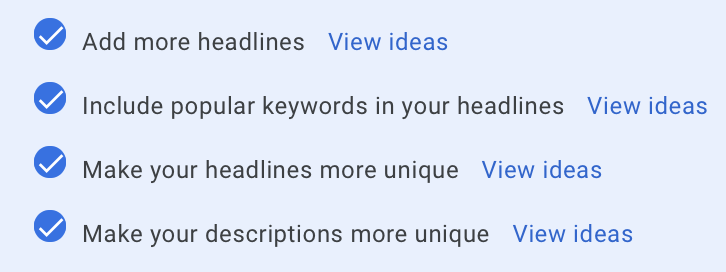Depending on how closely you pay attention to the Google Ads interface, you may have noticed a donut chart evaluating the strength of your ad copy. This chart represents Ad Strength which purportedly indicates the relevance and diversity of your ad combinations in a given ad group. Thanks to the advent of responsive text ads, Google dynamically pieces together variants for searchers it thinks will be mostly to achieve a click. Google aims to encourage pay-per-click (PPC) advertisers to develop a high volume of variants meeting its quality standards.
There are 4 ad strength ratings one can receive: Poor, Average, Good and Excellent. The ad copy interface’s donut chart will fill up as a given ad progresses through the scoring system. Here’s what they look like:




If you have a lot of ad variations in your account, you may find that they range in Ad Strength. Even if you’re an exceptional digital marketer or copywriter, you may be disappointed to find that many of your ads have sub-optimal ad strength ratings. This is a problem because poor or average ad strength ratings can handicap the frequency in which your ads show and ultimately impact your ad rank. Thus, they need to be address with updates.
Unfortunately it can often feel like a mystery to achieve higher ratings. You might think you’ve done all you can to develop high-quality, compelling PPC ad copy and on a human-level, you have! But remember, Google evaluates ad copy using automation which we must account for. Frankly, the key to writing ads with excellent ad strength has more to do with manipulating the combination of keywords used in both the ad group and the copy itself than most people realize. This is the dirty little secret about ad strength. Fortunately there are several things you can do to quickly and easily improve your ad strength:
Write a Complete Ad
Adjacent to the Ad Strength donut chart is a checklist of factors that constitute ad strength. We will need each checklist to be full to achieve an excellent rating. The easiest items in this list to complete are “Add more headlines” and “Make your descriptions unique.” To complete the “Add more headlines” item, you will need to write at least 10 unique headlines. Despite this, you should always strive to have a complete set of 15 headlines.
To complete the “Make your descriptions unique” item, you will need to write at least 3 descriptions for your ad. Once again, it’s best to write the complete set of 4 descriptions so as to maximize your ad strength score.

Use All Suggested Keywords in Your Headlines
There is a list of 2-6 keywords above the headline input boxes. This list comes directly from you ad groups keywords and is usually based on keyword search volume. What many Google Ads users fail to realize is that this list isn’t a suggestion, but a request from Google to shape your headlines. If these keywords are not used in your headlines, you will almost always struggle to achieve excellent ad strength.
As you add these keywords to your headlines you will see a green checkmark appear next to the phrase. Although they do not need to be added verbatim to a headline. Each word in the phrase should be added in the order it appears. Keep in mind that you can (and should) augment shorter-length keywords with additional words to make it more compelling. You can also use close variants of specific words to attain the green checkmarks.

Ensure Headlines Are Still Diverse and Avoid Repetition
The temptation of the suggested keywords feature is to repeat the same phrases only with subtle variations. While you may be able to achieve an ad strength rating of “good,” it’s unlikely you’ll achieve an “excellent” rating. Remember, your ad copy is still intended to market to human beings, not automated review systems. If you’ve read or seen any of Google’s statements about quality, you’ll know that the company places a priority on helpful, satisfying experiences. This holds true with the experience on search results pages (SERPs) too.
When crafting headlines, my recommendation is to try some phrases that are completely different than the keywords within the ad group but still convey your business’s value propositions. If possibly, try to include the same calls-to-action (CTAs) used on the landing page in your copy too.
Keep the Keyword Volume in Your Ad Groups Low
You may find that the keywords contained within your ad group are so vastly different that it’s impossible to include them as headlines and still develop coherent copy. When this happens, it’s a likely sign that you’re targeting too many keywords (or ones that are too dissimilar) in your ad group. As a solution, you should split these ad groups into more granular themes and develop more relevant ad copy for each.
Conclusion
It may seem or feel daunting to craft all of the different variants needed to power a responsive search ad. Even more so when trying to achieve an ad strength rating of “excellent.” Ingenuity, a willingness to experiment and patience are all useful attributes for a marketer going through this process. Challenge yourself to get creative in your copy writing. Carve out sufficient time to tweak and edit copy within the Google Ads interface. Don’t get frustrated if you don’t achieve the score you’re looking for right away. Try it again if necessary.
At Riviea, we craft Google Ads campaigns that achieve the maximum ad strength scores and drive results for our clients. If you’re struggling with your campaign’s performance, we’d love to discuss how we can help fix that. Visit our contact page to get in touch with Riviea today.

0 Comments